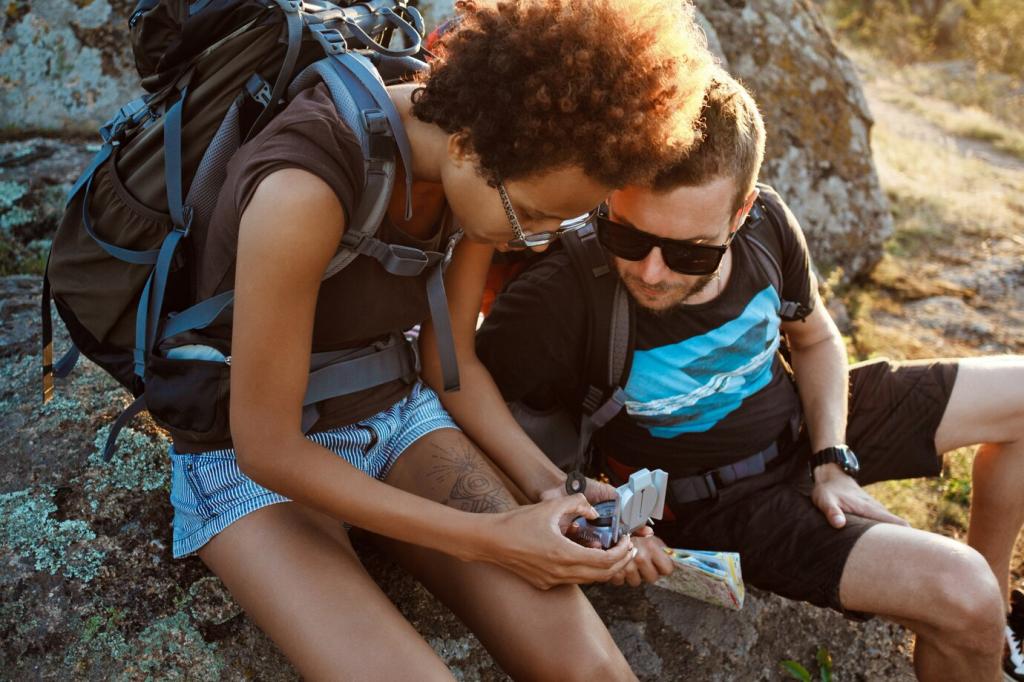Training Tips for Mountain Hiking Enthusiasts
Today’s chosen theme: Training Tips for Mountain Hiking Enthusiasts. Ready to turn steep climbs into joyful challenges? Explore practical, field-tested guidance that builds stamina, strength, and confidence—then subscribe and share your progress so our community can cheer you on.

Build Your Aerobic Engine for Long Climbs
Spend 60–90 minutes at a conversational pace two to four times per week, choosing rolling terrain or gentle trails. Increase your weekly time or distance by about ten percent. What routes help you stay easy and consistent? Share a favorite loop below and inspire another hiker’s base-building plan.
Strength and Power for Ascents and Descents
Foundational Leg Strength
Train squats, lunges, and step-ups two to three times per week, prioritizing quality movement. Add controlled eccentric work—slow lowers on step-downs—to prepare for punishing descents. Progress by increasing height, reps, or pack weight gradually. Share your favorite leg routine or a small win from last week.
Core and Posterior Chain Stability
Use deadlifts or hip hinges, planks, side planks, and anti-rotation presses to reduce sway when carrying a heavy pack. Strong glutes and hamstrings keep hips level on off-camber terrain. Two short sessions weekly work wonders. What core move changed your hiking posture most? Let us know.
Power and Plyometrics, Done Safely
Introduce low-impact plyometrics like box step-ups with a quick drive, gentle hops, or bounding on soft surfaces. Warm up thoroughly, keep volume low initially, and rest forty-eight hours between powerful sessions. Do you practice power for rocky scrambles? Share how you keep impact manageable.
Altitude, Breathing, and Acclimatization
Gradual Ascent and Sleep-Low Strategy
Increase sleeping elevation conservatively—around 300–500 meters per night—and schedule a rest day every three to four days. When possible, climb higher during the day and sleep lower. This steady approach helps your body adapt. What acclimatization schedule has worked for you? Share your sample plan.
Breathing Cadence and Rhythm on Steep Slopes
Match breath to steps: try two steps inhale, three steps exhale on moderate grades, and switch to steady, pressurized exhales when it gets steep. Keep shoulders relaxed and your pack balanced. Have a breathing trick that calms effort quickly? Post it to help fellow climbers.
Recognizing Altitude Illness Early
Watch for persistent headache, nausea, unusual fatigue, or dizziness. Do not ascend with worsening symptoms; descend and rest. Hydration helps general performance but is not a cure. What early warning sign do you monitor first? Comment so others know what to look for up high.
Progressive Pack Loading
Begin with five to ten percent of your body weight and increase gradually as your tissues adapt. Focus on time on feet before adding heavy weight. Keep straps snug, weight close to your back, and evaluate hotspots. What’s your current training load? Share your progression ideas.
Stairwells, Scrambles, and Sidehilling
Use stairwells for steady vertical, low boulders for controlled scrambles, and grassy slopes for sidehilling drills. Practice edging with your shoes and light pole taps for balance. These sessions build confidence where trails get sketchy. What local terrain helps you simulate mountains? Drop a pin for others.
Poles Technique and Downhill Control
Lengthen poles slightly for descents, plant them just ahead of your feet, and keep elbows relaxed. Let your hips glide behind your knees to absorb impact. Poles can reduce knee load and improve rhythm. Which technique cue helps you most? Share to help someone’s next descent.
Mobility, Balance, and Injury Prevention
Daily Ankle and Hip Mobility
Spend ten minutes on calf raises, ankle dorsiflexion drills, hip openers, and gentle hamstring work. Mobility improves stride length and stability on rock steps. Pair mobility with light activation before hikes. Which drill makes your feet feel springy? Share your routine to inspire others.
Proprioception and Balance Routines
Practice single-leg balances, eyes-open then eyes-closed, progressing to soft surfaces. Add lateral hops and controlled pauses to strengthen peroneals and arches. This protects ankles on hidden roots and talus. What balance challenge keeps you honest? Post your favorite progression for the community to try.
Smart Progression and Pain Red Flags
Follow the ten percent rule for weekly volume and schedule a lighter deload every three to five weeks. Address persistent pain early, not after a big trip. What recovery cue tells you it’s rest time? Share your signal so others learn to listen sooner.
Eat a balanced pre-hike meal rich in carbohydrates and a bit of protein. During long efforts, aim for roughly thirty to sixty grams of carbohydrates each hour. Test foods in training, not on big objectives. What snacks never let you down? Share your packable favorites.
Fuel, Hydrate, and Thrive on the Trail
Sip consistently, targeting roughly 0.4–0.8 liters per hour depending on heat and intensity. Consider sodium in the 300–600 mg per hour range during sweaty efforts. Practice to personalize. Notice thirst, urine color, and body mass changes. What’s your heat strategy? Teach the community your tweaks.
Fuel, Hydrate, and Thrive on the Trail
Mindset, Navigation, and Safety Rehearsals
Break climbs into waypoints—next tree, next bend, next cairn—and pair them with a calming mantra. Check perceived exertion often to avoid overreaching. What mental cue steadies you on crux pitches? Share it to help teammates through rough patches.
Mindset, Navigation, and Safety Rehearsals
Practice map and compass at local parks: set bearings, backstop with terrain features, and confirm time estimates between points. Confident navigation reduces stress and wasted energy. What drill sharpened your nav skills most? Post a mini-exercise for readers to try this week.
Recovery, Sleep, and Periodization
Weekly Structure That Respects Fatigue
Organize training with two harder days separated by recovery: one long hike, one interval session, one to two strength days, and easy aerobic filler. Adjust for life stress honestly. How do you balance busy weeks? Share your template to help others adapt sustainably.
Sleep as a Performance Multiplier
Aim for seven to nine hours nightly and build a modest sleep bank before big trips. Keep pre-bed routines simple: dim lights, stretch, and hydrate lightly. What sleep habit most improved your training? Drop a tip that helps someone climb fresher tomorrow.
Active Recovery and Post-Training Care
Use easy walks, gentle cycling, and light mobility to increase blood flow the day after hard efforts. Elevate legs, self-massage tight calves, and prioritize twenty to thirty grams of protein. What recovery ritual resets you fastest? Share your go-to routine with the community.
